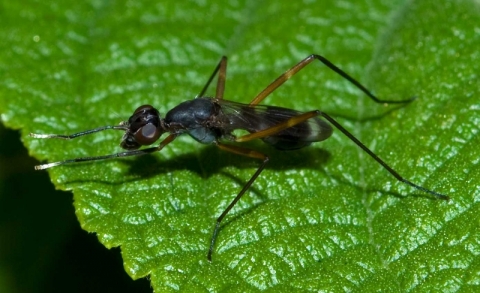When you start looking around even a small yard (my entire acreage consists of less than 1/4 acre in a suburban setting), you start to notice things you hadn’t known existed before. For instance, lately I’ve been on a bit of a wasp kick, having found both males and at least one female of a species of Scoliid wasp (Campsomeris dorsata) that hasn’t yet been officially recorded on the mainland. After that find, I started looking at the common “paper wasps” in the yard, and discovered that one of them (perhaps not the only species I have, but the only one I’ve had identified by the friendly folks at bugguide.net) is Polistes dorsalis, a relatively common species that makes its living in shrubbery.
But now that my search engine is set to “wasp,” I find that I’ve tried to turn everything into a wasp, even some innocent flies! Sometimes, though, I have help in that regard: some flies have evolved very convincing mimicry of wasp appearances.
Take the other evening. Daniel, for once, went to bed while it was still daylight outside, so I was able to prowl the evening calm with my camera. And I found this insect resting on a beautyberry leaf:
With that wasp-like waist, I was pretty convinced I’d found another wasp species. Turns out, though, that this is a fly, a member of the order Diptera, rather than a wasp, order Hymenoptera. Like some other flies, it’s a nonstinging but convincing mimic of a stinging insect.
There aren’t many species of Micropezidae (the family to which this fly belongs) in the United States; only 33 all told. But despite the relative paucity of species, the family has a surprising number of “common” names: they are variously known as small-footed, stilt-legged, or simply stilt, flies.
The individual pictured was quite tame, allowing me to approach very closely with the camera. Unfortunately, this docility led me to a bit overconfident, and after snapping a few images whose focus was upset by the leaf waving in the light evening breeze, I reached out to steady the plant. That proved too much for even this tame fly, and off it flew, leaving me with only the one nearly focused image, which was insufficient to identify this guy to the species level. The farthest the bug experts are willing to take this ID is to the subfamily level: it’s a member of the Taeniapterinae subfamily of Micropezidae.
One thing this family of flies has in common is their habit of sticking their front legs out in front of them to mimic the antennae of the biting or stinging hymenopterans (ants or wasps). You can see how long the legs of this beast are, and the white-tipped forelegs, in the image. That’s enough to clinch the identification to family, but not enough to key it out to species.
Oh, well.
Etymology: Micropezid=small feet, from the Greek micro, small, and peza, foot. The family name Micropezidae was erected in 1861 by Loew from the genus Micropeza, named by Meigen in 1803.

